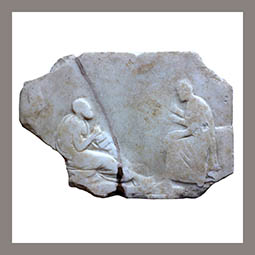Author: D. Russo
Download article as .pdf: Su un rilievo greco da una caupona pompeiana
 Based on its technical characteristics and archival documentation, the article re-examines a relief discovered in Pompeii in the 1950s during the excavations of Regio I but only published in 2018. The hypothesis advanced here is that the piece originates from Greece, where it may have originally served as the crowning block of a structure, such as a small base. The relief, depicting two intellectuals, was likely carved during the Hellenistic period, and later adapted for display in both Greece and Pompeii. In its final phase in the latter city, it likely did not decorate a house, as previously proposed, but instead adorned a caupona. There, it might have contributed, alongside other furnishings, the vegetation and poems painted on the walls, to evoke an image of a bucolic landscape.
Based on its technical characteristics and archival documentation, the article re-examines a relief discovered in Pompeii in the 1950s during the excavations of Regio I but only published in 2018. The hypothesis advanced here is that the piece originates from Greece, where it may have originally served as the crowning block of a structure, such as a small base. The relief, depicting two intellectuals, was likely carved during the Hellenistic period, and later adapted for display in both Greece and Pompeii. In its final phase in the latter city, it likely did not decorate a house, as previously proposed, but instead adorned a caupona. There, it might have contributed, alongside other furnishings, the vegetation and poems painted on the walls, to evoke an image of a bucolic landscape.
